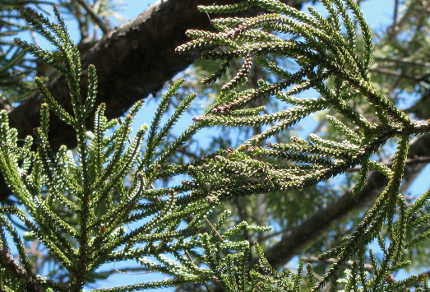At home in Nova Scotia, a windbreak of eastern white pines borders my yard, the trees having grown from sturdy saplings into robust giants during the nearly twenty years my family has lived on the property. When storms blow in from the Atlantic, the pines’ sprawling, needle-tufted branches lift and fall in restless motion as though echoing the roll of the sea.
Canada is home to a dozen native pines – eastern and western white pine, red pine, jack pine, limber pine, and so on – that contribute to the vast swathe of boreal forest which stretches from sea to sea north of rich, southern farmland, as well as the montane forest cloaking the slopes of the Rockies. All belong to the botanical family Pinaceae and share their habit of producing naked seeds in cones with other gymnosperms of the same family – the spruces, larches, firs, cedars, and hemlocks – that cohabit the cool, northern forests with them.
Here in Australia, the vegetation screen edging my yard includes a hoop pine that rises from a single thick trunk and splits into two trunks, with each encircled by a whorl of branches, and each branch bearing shoots covered with stubby, curved, pointed leaves. These leaves look unlike the needles of any native Canadian pines, and with good reason. Australian ‘pines’, as one might expect, belong to an entirely different taxonomic grouping than Canadian pines. In fact, the roughly 40 species of Australian pines belong to three botanical families – the Podocarpaceae, which includes the Huon, plum, and celery-topped pines, the Cupressaceae, which includes the cypress and King William pines and Tasmanian cedar, and the Araucariaceae, which includes the hoop, bunya, kauri, monkey puzzle, Norfolk Island, and Wollemi pines.

Hoop Pine Leaves (© Magi Nams)
A number of these Aussie pines possess intriguing traits. Celery-topped pines really do bear leaves that resemble those of celery plants, as Vilis and I discovered while hiking through Tasmanian temperate rainforests in March. In May, we and Janis observed bull kauris with bullishly-thick, cylindrical trunks and pinky-orange bark at Lake Barrine on the Atherton Tablelands, the trunks of those pines rising so high we really had no concept at all of what the leaves looked like. I have read that plum pines bear dusky purple seeds on fleshy edible stems, rather than in cones,1 and that the seed cones of bunya pines may attain the astonishing size of 40 centimetres diameter and weights exceeding 10 kilograms.2 As you can imagine, the falling cones of bunya pines present a serious hazard to unsuspecting humans out strolling in parks and other green spaces, a fact which has resulted in the removal of planted bunyas from many Australian parks and the periodic closure of other green areas. 2 Cumberland State Forest in the suburbs of Sydney, where bunya pines occur, has been declared off-limits to walkers for weeks at a time because of the danger of falling cones.2 No Canadian pine cone that I know of equates with potential death.
Perhaps the most intriguing of all the Australian pines is the Wollemi pine, which was completely unknown to European Australians and the world (even possibly to Aboriginal Australians3) until 1994, when a small, remnant population of twenty-three adult trees plus some saplings was discovered by an off-duty parks field officer who abseiled into an isolated canyon of the Wollemi wilderness only 100 kilometres northwest of Sydney.4 So puzzling was David Noble’s find that it stirred the botanical world into a flutter of excitement. Not only was the huge tree, with its bizarrely bubbled bark,5 drooping branches of twisted leaves, and bulbous, prickly cones6 a new species, it was an entirely new genus, bearing reproductive structures somewhere between those of Araucaria and Agathis, the two genera of trees within the family Araucariaceae.7 The new genus became Wollemia, named for the wilderness in which the trees were found, and the species Wollemia nobilis, meaning ‘noble’ and alluding to its discoverer.8
Careful examination of the pollen and leaves of the puzzling tree revealed they were identical to those of fossil pollen and leaves of a tree dated to the age of the dinosaurs.9 Tucked away in a canyon in eastern Australia lives one of the most ancient species of plants on the earth. I’ll never see it, except perhaps in a botanical garden one day, for that canyon is now so highly protected that the exact location of the trees is a closely-guarded secret and only researchers are allowed access.10 If, only sixteen years ago the Wollemi pine – a living fossil – was first discovered, how many more botanical mysteries, botanical dinosaurs, remain to be found on this ancient continent?
References:
1. Australian Government, Director of National Parks, Australian National Botanic Gardens. Conifers: Podocarpus elatus, Plum pine, Brown pine. Accessed 13-Aug-2010. http://www.anbg.gov.au/anbg/conifers/podocarpus-elatus.html
2. James Woodford. The Wollemi Pine: The incredible discovery of a living fossil from the age of the dinosaurs. 2000. Text Publishing, Melbourne, pp. 30-31.
3. Ibid, pp. 53-54; 4. Ibid, pp. 1, 13; 5. Ibid, p. 13; 6. Ibid, p. 44; 7 Ibid, p. 42; 8. Ibid, p. 45; 9. Ibid, pp. 58-59; 10. Ibid, prologue “A Warning.”

Hoop Pine Bark (© Magi Nams)


